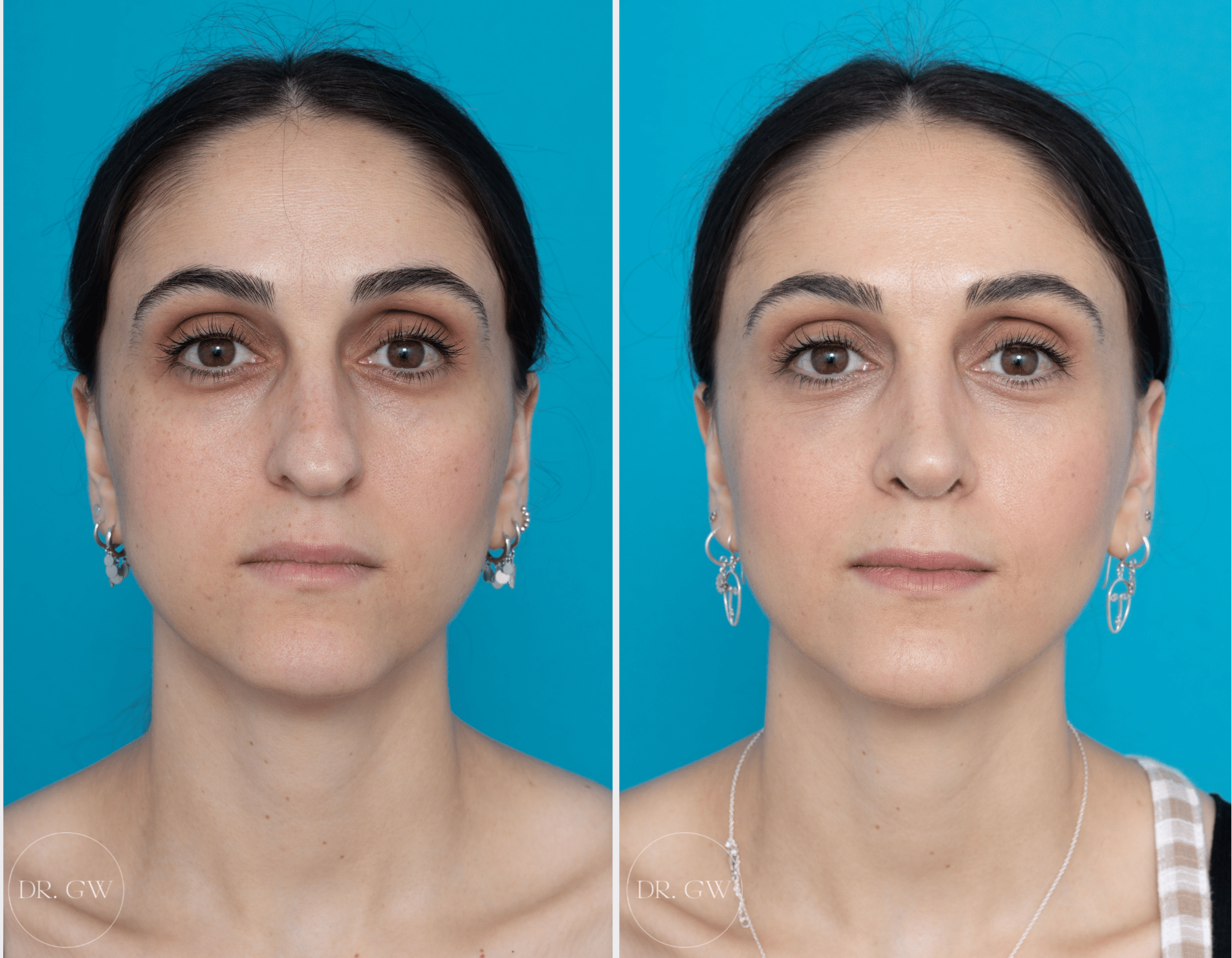
02 Aug Nose Shapes and the Different Types
Understanding Nose Shapes
The nose is one of the most prominent features on the face. It’s shape can make a significant impact on your overall appearance. Just as there are countless variations in facial features, there is a wide range of nose shapes. In this blog, we’ll explore different types of nose shapes, discuss how to work with their unique beauty, and suggest ways to compliment and accentuate their appearance if desired.
Based in Perth, Western Australia, Specialist Plastic Surgeon Dr Guy Watts, is performing nose jobs (Rhinoplasty) for patients interested in altering aspects of their nose. Dr Watts has experience performing both open and closed Rhinoplasty techniques.
Nose Shape is a Fundamental Feature of Facial Aesthetics
The nose is a fundamental feature of facial aesthetics, as it occupies a central position on the face and directly influences the overall harmony and balance of facial features. Its size, shape, and projection can either enhance or detract from the other features of the face.
- Facial Harmony: The nose plays a pivotal role in achieving facial harmony by creating a sense of balance and proportion with other features such as the eyes, lips, and cheekbones.
- Facial Symmetry: A symmetrical nose contributes to the overall perception of facial symmetry.
- Profile Projection: The nose influences the facial profile by determining the degree of forward projection.
- Cultural and Ethnic Identity: There is often an association between nose shape and specific cultural and ethnic backgrounds, reflecting the beauty and diversity of the human race.
Different Types of Nose Shapes
1. The Roman Nose
The Roman nose, also known as an aquiline nose, is a unique and prominent facial feature that exudes a strong sense of character.
Named after Romans, the term “Roman nose” is derived from its association with ancient Roman sculptures and portraits, where this nose shape was commonly depicted on prominent figures such as emperors and statesmen.
Historically, the Roman nose has been considered a symbol of strength, power, and authority. It was often seen as a feature that signified noble lineage and leadership qualities.
Throughout history, many famous figures have possessed Roman noses, including Julius Caesar, Napoleon Bonaparte, and George Washington. Their strong profiles have become iconic, further cementing the association between Roman noses and powerful personalities.
Characteristics of the Roman Nose
- Prominent bridge: The most distinguishing characteristic of the Roman nose is its prominent bridge, which often has a slight curve or bump.
- Downward slope: The Roman nose typically slopes downwards towards the tip, creating a convex shape that can make the nose appear elongated.
- Defined tip: The tip of a Roman nose is usually well-defined and may be slightly bulbous, adding to the overall prominent appearance.
2. Greek Nose
The Greek nose, characterised by its straight and narrow shape, is considered a classic symbol of beauty and refinement.
The Greek nose is named after its prevalence in classical Greek art, particularly in sculptures and paintings of gods and goddesses. This association with divine beauty has contributed to the enduring appeal of the Greek nose.
Characteristics of the Greek Nose
- Straight bridge: The most notable feature of the Greek nose is its straight, narrow bridge, which maintains a consistent width from the forehead down to the tip of the nose.
- Minimal curvature: Unlike the Roman nose, the Greek nose has minimal curvature.
- Refined tip: The tip of a Greek nose is typically well-defined and slightly upturned, enhancing its overall delicate and refined look.
3. The Snub Nose
The snub nose, characterised by its small size and slightly upturned tip, is a unique facial feature that exudes a sense of playfulness. The snub nose is small in size and with an upturned tip.
Characteristics of the Snub Nose
- Small size: The snub nose is generally smaller in size in comparison to other nose shapes.
- Upturned tip: One of the most notable features of the snub nose is its slightly upturned tip.
- Rounded contours: The snub nose typically has rounded contours, with a subtle and smooth curvature from the bridge down to the tip.
4. The Nubian Nose
The Nubian nose, characterised by its wider base, large nostrils, and rounded tip, is a distinct and beautiful facial feature commonly found among people of African descent. This nose is a proud representation of African heritage, showcasing the rich diversity of facial features found among people of African descent.
In recent years, there has been a growing appreciation for the beauty and uniqueness of the Nubian nose, with more people embracing their natural features and rejecting narrow, Eurocentric beauty standards.
Characteristics of the Nubian Nose
- Wider base: The Nubian nose is known for its wider base, which gives it a more robust and distinctive appearance compared to other nose shapes.
- Large nostrils: One of the key features of the Nubian nose is its large, open nostrils.
- Rounded tip: The tip of a Nubian nose is typically rounded and full, adding to its overall distinctive appearance.
5. The Celestial Nose
The celestial nose, also referred to as the upturned nose, is a distinct facial feature characterised by its slightly upturned tip and elegant curvature. The celestial nose has an upturned tip and delicate curvature.
Characteristics of the Celestial Nose
- Upturned tip: The most notable feature of the celestial nose is its slightly upturned tip.
- Graceful curvature: The celestial nose has a convex curvature from the bridge to the tip.
- Well-defined bridge: The bridge of a celestial nose is typically well-defined and may be slightly narrow, contributing to its profile.
6. The Hawk Nose
The hawk nose, also known as the aquiline or hooked nose, is a unique and prominent facial feature characterised by its pronounced curve and angular appearance. The term “hawk nose” comes from its resemblance to the beak of a bird of prey, such as a hawk or an eagle. This association with powerful and predatory animals has contributed to the enduring appeal of the hawk nose.
Characteristics of the Hawk Nose
- Pronounced curve: The most distinguishing characteristic of the hawk nose is its pronounced curve, which often resembles the beak of a bird of prey.
- Angular profile: The hawk nose has an angular profile, with the bridge of the nose forming a prominent angle as it descends toward the tip.
- Pointed tip: The tip of a hawk nose is usually well-defined and may be slightly pointed, adding to the overall striking appearance.
Achieving Balanced Nasal Aesthetics with Surgery
Rhinoplasty, commonly referred to as a “nose job,” is a surgical procedure designed to reshape and alter the nose, bringing it into harmony with other facial features. We will discuss the role of Rhinoplasty in achieving balanced nasal aesthetics, the types of Rhinoplasty procedures available, and the factors to consider when contemplating surgery.
The Role of Rhinoplasty
- Addressing aesthetic concerns: Rhinoplasty can address a wide range of aesthetic concerns, including the size, shape, and projection of the nose.
- It can help create a more balanced and harmonious facial appearance by altering the nose’s overall proportions.
- Correcting asymmetries: Rhinoplasty can help correct nasal asymmetries, increasing facial symmetry.
- Ethnic and cultural considerations: Experienced surgeons will tailor Rhinoplasty procedures to maintain or accentuate an individual’s unique ethnic or cultural identity.
Types of Rhinoplasty Procedures
Open Rhinoplasty
Open Rhinoplasty involves making an incision across the columella (the tissue separating the nostrils) to access the nasal structure. This approach provides greater visibility and precision for the surgeon but may result in a slightly more visible scar.
Closed Rhinoplasty
Closed Rhinoplasty involves making incisions inside the nostrils, eliminating visible scarring. This approach may be suitable for less complex cases or for those who prefer a less invasive procedure.
FAQs about Different Types of Nose Shapes
What are the most common nose shapes?
- There is no one “most common” nose shape, as there is a wide variety of nose shapes within each population. However, some studies have found that certain nose shapes tend to be more prevalent in certain populations. For example, people of African descent tend to have wider and flatter noses, while people of European descent tend to have narrower and more prominent noses.
Can you change the shape of your nose?
There are various cosmetic procedures that can alter the shape of the nose, including Rhinoplasty and Septoplasty, as well as non-surgical treatments like injectable fillers.
It’s important to note that these procedures come with risks and potential complications. It is important to be aware of these before undergoing surgery.
Does genetics determine nose shape?
- Yes, genetics largely impact on the shape of the nose. However, environmental factors such as injury or disease can also affect the shape of the nose.
Can nose shape affect breathing?
- Yes, certain nose shapes can affect breathing. For example, a deviated septum (where the cartilage that separates the two nostrils is crooked or misaligned) can cause difficulty breathing. Additionally, a narrow or constricted nasal passage can also lead to breathing problems.
What is the significance of nose shape in different cultures?
- Nose shape has held significance in different cultures throughout history. For example, in ancient Egypt, a long, straight nose was a sign of beauty and nobility.
- In some Native American cultures, a hook nose was seen as a symbol of both strength and wisdom.
- It’s important to note that assigning value or meaning to certain physical traits can perpetuate harmful stereotypes and discrimination.
Further Reading about Nose Surgery with Dr Watts
- Rhinoplasty Surgery Page
- Nasal Reconstruction Surgery Page
- Non-Surgical Rhinoplasty Page
- Blog About Top 5 Ways To Improve Your Nose
- Turkish Rhinoplasty
Medical References about Nose Surgery
- Ear, Nose Deformities – Mayo Clinic
- Nose: Anatomy, Function, Sinuses, Septum, Turbinates – Cleveland Clinic
- Anatomy of the Nose: What to Know – Web MD
Dr. Guy Watts – Specialist Plastic Surgeon In Perth WA
Dr. Guy Watts (AHPRA Medical Reg. MED0001539378) is a Specialist Plastic Surgeon with an extensive career that spans across renowned plastic surgery clinics worldwide. His exceptional expertise has been honed through invaluable experiences at esteemed establishments such as the prestigious New York Eye and Ear Infirmary and the renowned Pitanguy Clinic in Brazil.
Having collaborated with the foremost cosmetic plastic surgeons on a global scale, Dr. Watts has chosen to return to Perth after a remarkable 17-year journey of intensive training and invaluable professional experience to bring the latest practices and technology in cosmetic plastic surgery to his patients.
Dr. Watts is a Fellow of the Royal College of Surgeons (FRACS) and a Member of the Australian Society of Plastic Surgeons (ASPS), Australasian Society of Aesthetic Plastic Surgeons (ASAPS) and the International Society of Aesthetic Plastic Surgeons (ISAPS).







